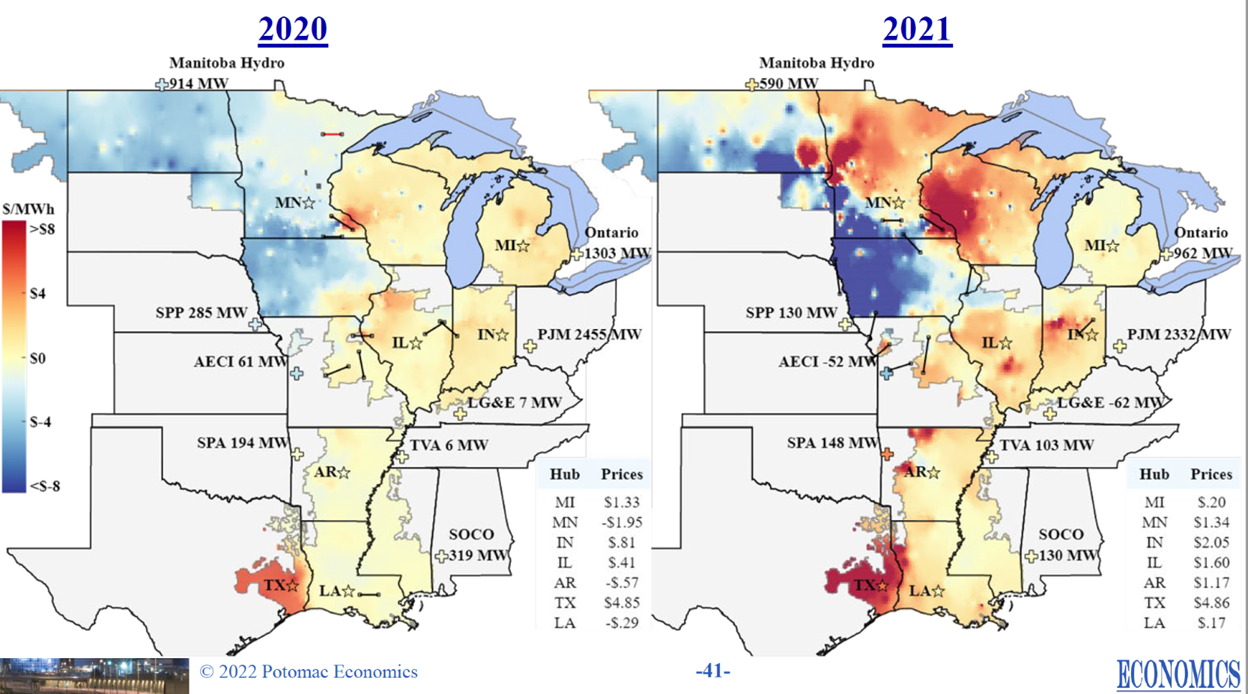MISO board approves $10.3 billion transmission portfolio enabling massive carbon reduction

On July 25, 2022, the Midcontinent Independent System Operator (MISO), which operates the wholesale electric power market for Minnesota and 14 other states, approved $10.3 billion of investments in new long-range transmission projects across the upper Midwest. This is the largest single long-range transmission investment to occur in the United States. Read Fresh Energy’s public statement here.
Planning and approval of this investment, which comes in the form of clean energy transmission lines, has been years in the making and will enable thousands of megawatts of renewables and will result in millions of tons of carbon reductions. Thanks to the newly approved spending, Minnesota will benefit from three new transmission lines to be built in the next eight years, with final in-service dates expected in 2028 and 2030. These transmission lines will follow existing rights of way and help reliably connect renewable resources to customers across Minnesota and neighboring states. This approval comes after years of advocacy and analysis by Fresh Energy and partners, including more than two years of direct stakeholder process at MISO with its members and stakeholders, including Fresh Energy.

This latest investment plan is the first of at least four such plans that are expected to be approved by MISO over the coming years. This investment is expected to yield between $23 billion to $52 billion in financially quantifiable benefits stemming mostly from eliminating the need for certain new fossil power plants being built, decreasing the reliance on fossil fuels to generate power, a decreased risk of rolling blackouts, and decarbonization. This wide range in monetary value is based on the use of different assumptions about the future, but it shows that even a conservative estimate will bring benefits that more than double the cost. Furthermore, transmission allows for a more cost-effective allocation of electricity generation, meaning that the most expensive electricity resources—which are usually fossil fuel based—will be online less often, and that renewables will be easier to access by customers across the grid. This in turn leads to lower electricity costs (renewables are historically much less expensive than fossil fuel), off-setting the cost of this transmission portfolio.
From a decarbonization standpoint, this latest investment will increase MISO’s capacity to handle new renewable generation by nearly 50 percent, allowing more than 20 gigawatts of new wind and solar generation to power our grid. Taken together with expanded transmission leading to less reliance on fossil fuels, the investment approved today will lead to the removal of 399 million metric tons of CO2 over the next 20 years compared to what would have occurred without the new transmission lines. This is equivalent to taking 50 natural gas power plants offline and keeping them offline for the next 20 years.
One of the biggest challenges facing the rollout of renewable energy today is the difficulty that solar and wind resources face in trying to send their power to large power consumers, such as cities and manufacturing centers. The maps below show the typical level of “congestion” experienced within MISO during 2020 and 2021. The areas shaded in blue show cheaper real-time electricity prices, and mostly stem from wind power produced in the Dakotas, Minnesota, and Iowa. The red areas show where real-time power is more expensive, which is usually the result of congestion in the transmission system. Congestion, which is akin to a traffic jam, occurs because there isn’t enough space on the transmission system to deliver the supply of cheaper power to places that demand it. When congestion occurs, more expensive fossil fuel-based power is used to provide electricity to customers, leading to higher prices (the red on the map) and to the “curtailment” of renewable power—essentially turning off wind turbines because the power can’t reach places where it is needed. This latest round of transmission investment will help relieve much of that congestion, creating more opportunity for wind and solar developers across our state, and increasing access to renewable energy across Minnesota as a whole.

In Minnesota, the lines will be constructed and operated by the state’s major utilities, dependent upon where each proposed line overlaps with various service territories. These utilities have 90 days to notify the Minnesota Public Utilities Commission of their intent to build these lines, and then another 18 months to file for a Certificate of Need from the Commission. The Commission then has another year to grant or deny a Certificate of Need, during which time the Commission will open a public comment period. MISO approved the transmission portfolio today on the expectation that the transmission lines in Minnesota will follow existing rights of way.
Fresh Energy will continue to actively work with MISO to ensure that future high voltage transmission investments help Minnesota reach its goal of 100% carbon-free electricity by 2040. We will also be deeply involved in the proceedings before the Commission by providing expert research and testimony, helping Minnesotans engage in the process, and in building public support for the work—all to ensure that the lines approved today will be built in a just, equitable, and cost-effective way.
